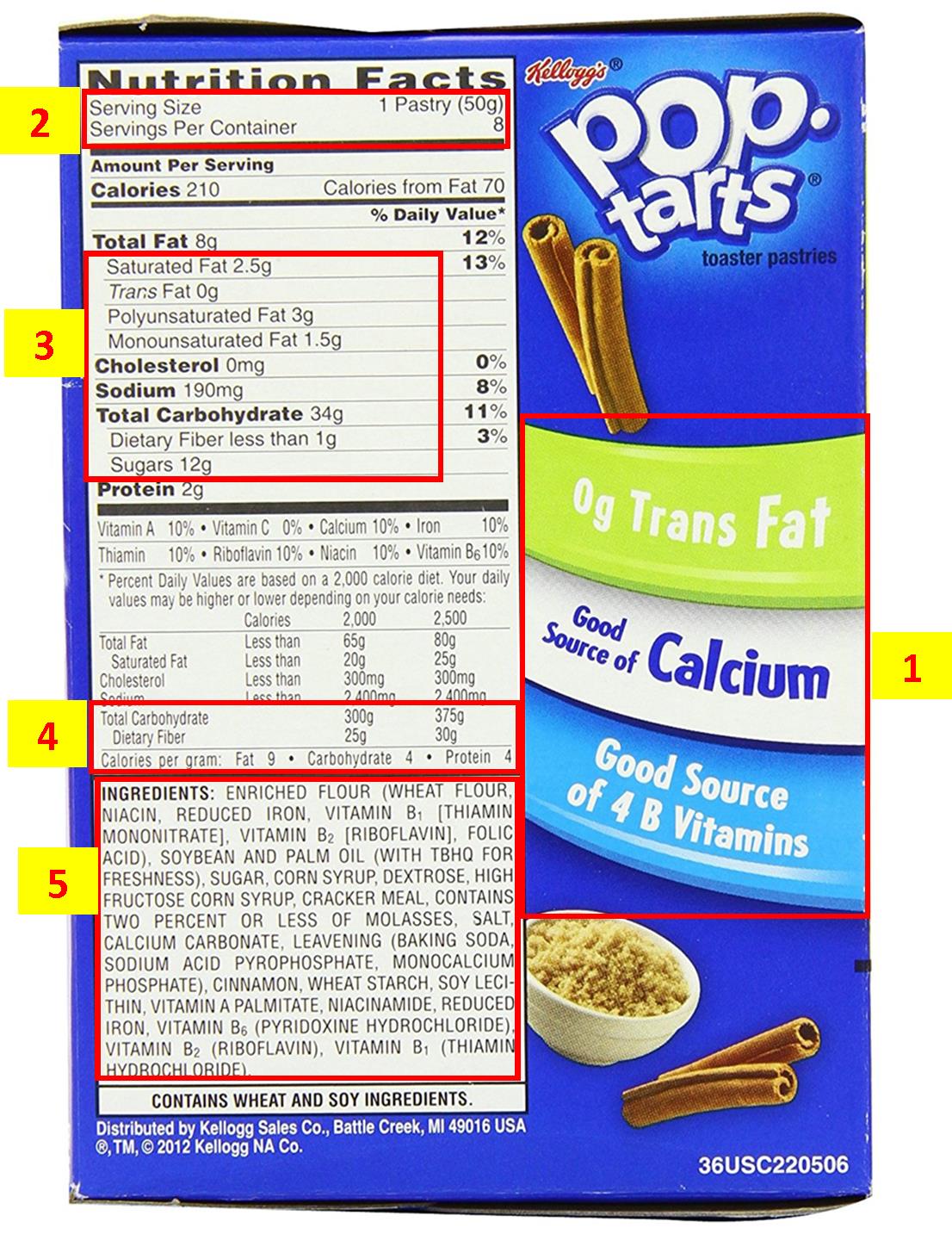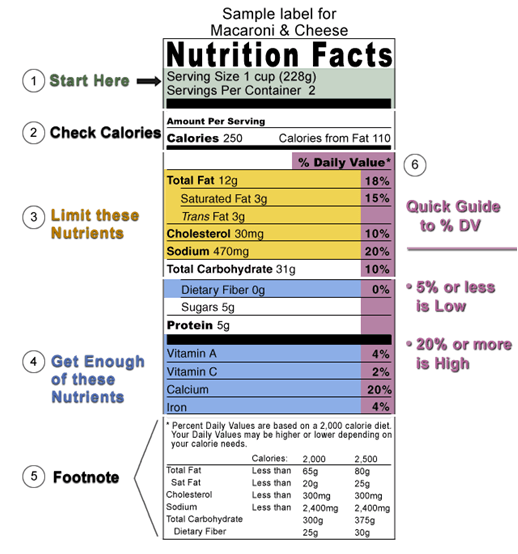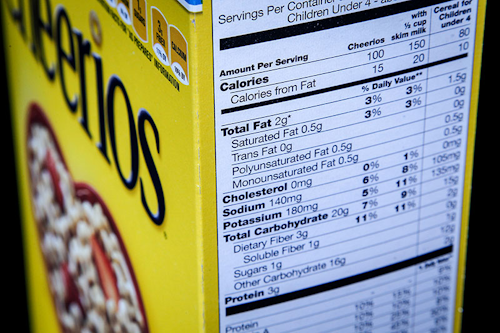39 understanding nutritional facts on labels
How to Understand The Nutrition Facts Label - AFPA Fitness Calories are perhaps the most famous element of the nutrition facts label. Calories are a measure of energy that a food provides, and in the context of the nutrition facts label, it reports how many calories a food provides per serving. There is no need to be scared of calories! All living beings need calories to survive and thrive. Learning To Read Labels :: Diabetes Education Online View an example of a Nutrition Facts label showing how to count sugar alcohols. Self-assessment Quiz. Self assessment quizzes are available for topics covered in this website. To find out how much you have learned about Understanding Carbohydrates, take our self assessment quiz when you have completed this section. The quiz is multiple choice.
Understanding Nutrition Fact Labels | Penn Highlands Healthcare Understanding Nutrition Fact Labels. One of the best ways to take greater control of your health is by better understanding what you eat and drink in a day. Fortunately, the Nutrition Fact labels on nearly everything we buy gives us this exact information. ... For example, if you eat a half serving, you will consume half of the calories listed ...
Understanding nutritional facts on labels
How to Understand and Use the Nutrition Facts Label | FDA Feb 25, 2022 · Overview. The information in the main or top section (see #1-4) of the sample nutrition label (below) can vary with each food and beverage product; it contains product-specific information ... Help patients understand Nutrition Facts labels to eat smarter This video provides a general overview of the four key sections of the Nutrition Facts label: servings, calories, percent Daily Value and nutrients. The video offers practical guidance for patients on how to use the Nutrition Facts label to compare packaged foods and beverages and make informed dietary choices. Food Labels 101: Understanding the Nutrition Facts Label A sodium level of 140 mg or less on the nutrition facts label is considered low sodium. This is an essential number to look for when reading the label. Total Carbohydrates - Fiber and Sugar Foods high in fiber can be beneficial to a healthy diet, as fiber helps manage blood sugar levels and can lower cholesterol.
Understanding nutritional facts on labels. Understanding Food Labels | The Nutrition Source | Harvard T ... The Nutrition Facts Label. The Nutrition Facts label is overseen by the U.S. Food and Drug Administration (FDA) and was first mandated under the Nutrition Labeling and Education Act of 1990 to help consumers make quick, informed food choices. It has undergone revisions, with the latest update released in 2016. Changes are generally based on updated scientific information and input from the public regarding ease of use. Understanding Nutrition Labels - News-Medical.net The calorie information is the second part of the nutrition label. It states the number of calories present in one serving. For example, 1 serving of nuts contains 150 calories. If you consume 2... Understanding Nutritional Labels | Beaumont | Beaumont Health So remember that when doing your math. Here are the parts of most food labels: Calories (total calories and calories from fat) - This part of the label tells you how many calories each serving has and how many of those calories come from fat. Total Fat - Total fat is the number of fat grams per serving. There are different types of fat. Understanding Nutrition Facts on Food Labels - WebMD Serving Size: An Important Part of Food Labels. At the top of the Nutrition Facts section, you'll see the serving size (such as 1/2 cup, five crackers, or 10 chips) and servings per container (such as two, four, six). The food label then lists the number of calories, grams of fat, grams of saturated and trans fat, etc., per serving.
The Basics of the Nutrition Facts Label Mar 04, 2022 · You know about calories, but it also is important to know about the additional nutrients on the Nutrition Facts label. Protein: A percentage Daily Value for protein is not required on the label. Eat moderate portions of lean meat, poultry, fish, eggs, low-fat milk, yogurt and cheese, plus beans and peas, nuts, seeds and soy products. Understanding Ingredients on Food Labels | American Heart ... Mar 06, 2017 · Food labels are an important source of information about calories and the nutritional value of the foods you eat, a crucial tool in building a heart-healthy diet. The Nutrition Facts information is always displayed in the same orderly fashion and helps you understand how much of certain nutrients that you need to limit are contained in the ... The New Nutrition Facts Label | FDA - U.S. Food and Drug ... Apr 13, 2022 · En Español (Spanish) The U.S. Food and Drug Administration (FDA) has updated the Nutrition Facts label on packaged foods and drinks. FDA is requiring changes to the Nutrition Facts label based on ... Reading Food Labels | ADA - American Diabetes Association It’s time to decode those food claims. Trying to figure out nutritional information on labels and packaging isn’t easy. The good news is that we can help. Untangle packaging claims. If you get tripped up on food content claims, you’re not alone. Fat free vs. low fat vs. reduced fat. Low ...
Understanding Food Nutrition Labels | American Heart Association 1 - Start with the serving information at the top. This will tell you the size of a single serving and the total number of servings per container (package). 2 - Next, check total calories per serving and container. Pay attention to the calories per serving and how many calories you're really consuming if you eat the whole package. Understanding Food Nutrition Labels | EmPOWERED To Serve The U.S. Food and Drug Administration (FDA) regulates the Nutrition Facts label seen on packaged foods and drinks. In 2016, the FDA released changes to the label to make it easier to see how many calories and added sugars are in a product and to make serving sizes more realistic. These changes are still being implemented throughout the food ... Nutrition Facts Label: Understanding the Label | Extension | University ... Calories refers to the total number of calories, or "energy," supplied from all sources (fat, carbohydrate, protein, and alcohol) in one serving of the food. As a general guide: 100 calories per serving of an individual food is considered a moderate amount, and 400 calories or more per serving of an individual food is considered high in calories. Learn How the Nutrition Facts Label Can Help You Improve Your Health Nutrients Required on Label Vitamin D and potassium values are required. Calcium and iron will continue to be required. Vitamins A and C will no longer be required but can be included on a voluntary basis. Slight Decrease in Sodium Allowance The daily limit for sodium decreased slightly from 2,400 mg per day to 2,300 mg per day.
Understanding Food Labels - Nutrition: Science and Everyday Application ... The FDA uses the following definitions for interpreting the %DV on food labels:4 5%DV or less means the food is low in a nutrient. 10% to 19%DV means the food is a "good source" of a nutrient. 20%DV or greater means the food is high in a nutrient.
How to Read Everything on the Nutrition Facts Label - Food Network The American Heart Association recommends no more than 100 calories from added sugar per day (about 6 teaspoons or 24 grams of sugar) for most women and no more than 150 calories per day (about 9 ...
PDF How Do I Understand the "Nutrition Facts" Label? intake will help you reduce the number of calories you eat. • Saturated Fat — is considered a "bad" fat. Eating too much can raise your cholesterol level (and LDL or bad cholesterol) and your risk of heart disease and stroke. Limit your saturated fat intake to less than 5 to 6% of your total calories. For a person who needs 2,000 calories
How To Read Food and Beverage Labels - National Institute on Aging At the top of the Nutrition Facts label, you will find the total number of servings in the container and the food or beverage's serving size. The serving size on the label is based on the amount of food that people may typically eat at one time and is not a recommendation of how much to eat. Read more about serving and portion sizes.
How to understand food nutrition labels | by Alpha Medical Team | Alpha ... Nutrient tables Most of the nutrition label is made up of a table listing various nutrients, the amount of that nutrient contained in the food, and the percent daily value. We'll start with the...
Understanding the Nutrition Facts Label - FamilyEducation Keep these low: saturated fats, transfats, cholesterol, and sodium. Get enough of these: potassium, fiber, vitamins A and C, calcium, and iron. Use the % Daily Value (DV) column when possible: 5% DV or less is low, 20% DV or more is high. Check servings and calories. Look at the serving size and how many servings you are actually consuming.
Food Labels | CDC - Centers for Disease Control and Prevention If you eat the whole thing, you are eating 8 times the amount of calories, carbs, fat, etc., shown on the label. Total Carbohydrate shows you types of carbs in the food, including sugar and fiber. Choose foods with more fiber, vitamins, and minerals. Choose foods with lower calories, saturated fat, sodium, and added sugars. Avoid trans fat.
Understanding the Nutrition Facts Label - Know Diabetes by Heart Remember that the information shown in the label is based on a diet of 2,000 calories per day. Your calories needs will vary depending upon your age, gender, activity level, and whether you're trying to lose, gain or maintain your weight. Carbohydrates. Determining the carb count





Post a Comment for "39 understanding nutritional facts on labels"